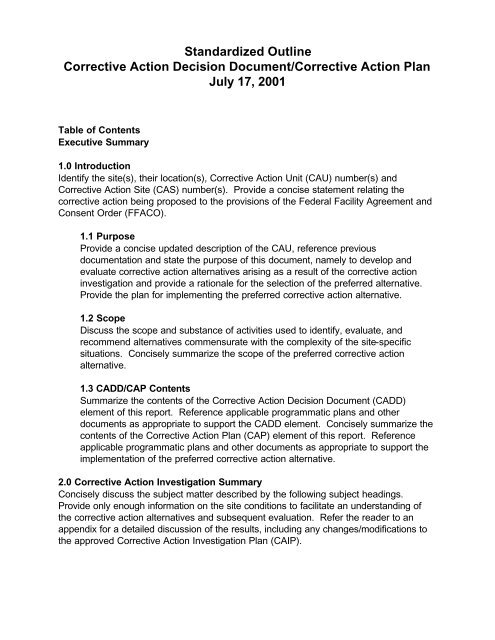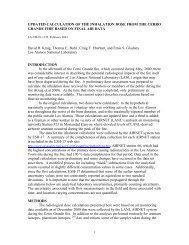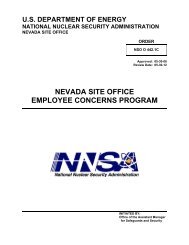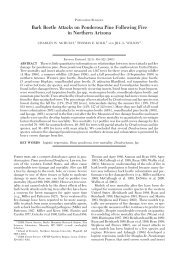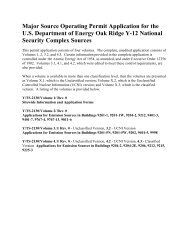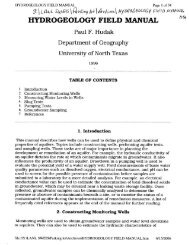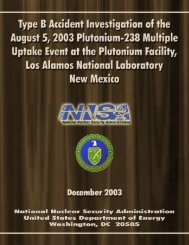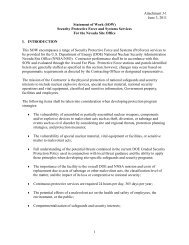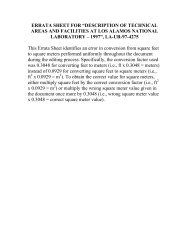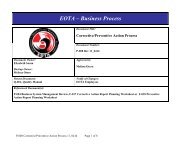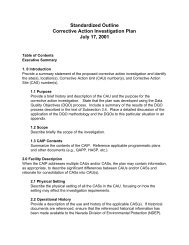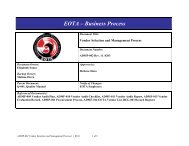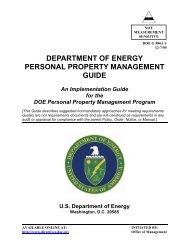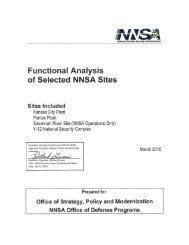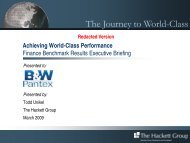Corrective Action Decision Document/Corrective Action Plan
Corrective Action Decision Document/Corrective Action Plan
Corrective Action Decision Document/Corrective Action Plan
You also want an ePaper? Increase the reach of your titles
YUMPU automatically turns print PDFs into web optimized ePapers that Google loves.
Standardized Outline<br />
<strong>Corrective</strong> <strong>Action</strong> <strong>Decision</strong> <strong>Document</strong>/<strong>Corrective</strong> <strong>Action</strong> <strong>Plan</strong><br />
July 17, 2001<br />
Table of Contents<br />
Executive Summary<br />
1.0 Introduction<br />
Identify the site(s), their location(s), <strong>Corrective</strong> <strong>Action</strong> Unit (CAU) number(s) and<br />
<strong>Corrective</strong> <strong>Action</strong> Site (CAS) number(s). Provide a concise statement relating the<br />
corrective action being proposed to the provisions of the Federal Facility Agreement and<br />
Consent Order (FFACO).<br />
1.1 Purpose<br />
Provide a concise updated description of the CAU, reference previous<br />
documentation and state the purpose of this document, namely to develop and<br />
evaluate corrective action alternatives arising as a result of the corrective action<br />
investigation and provide a rationale for the selection of the preferred alternative.<br />
Provide the plan for implementing the preferred corrective action alternative.<br />
1.2 Scope<br />
Discuss the scope and substance of activities used to identify, evaluate, and<br />
recommend alternatives commensurate with the complexity of the site-specific<br />
situations. Concisely summarize the scope of the preferred corrective action<br />
alternative.<br />
1.3 CADD/CAP Contents<br />
Summarize the contents of the <strong>Corrective</strong> <strong>Action</strong> <strong>Decision</strong> <strong>Document</strong> (CADD)<br />
element of this report. Reference applicable programmatic plans and other<br />
documents as appropriate to support the CADD element. Concisely summarize the<br />
contents of the <strong>Corrective</strong> <strong>Action</strong> <strong>Plan</strong> (CAP) element of this report. Reference<br />
applicable programmatic plans and other documents as appropriate to support the<br />
implementation of the preferred corrective action alternative.<br />
2.0 <strong>Corrective</strong> <strong>Action</strong> Investigation Summary<br />
Concisely discuss the subject matter described by the following subject headings.<br />
Provide only enough information on the site conditions to facilitate an understanding of<br />
the corrective action alternatives and subsequent evaluation. Refer the reader to an<br />
appendix for a detailed discussion of the results, including any changes/modifications to<br />
the approved <strong>Corrective</strong> <strong>Action</strong> Investigation <strong>Plan</strong> (CAIP).
CADD/CAP Outline July 17, 2001 Page 2<br />
2.1 Investigation Activities<br />
Provide a concise description of the investigation activities conducted at the site.<br />
Refer to and discuss the validity of the conceptual model developed in the CAIP.<br />
2.2 Results<br />
2.2.1 Provide summary analytical data, plume concentration isopleth maps<br />
or graphics that summarize the investigation results and affirm that based<br />
on these results the CAU has been adequately characterized.<br />
2.2.2 Summarize the assessment made in the Appendix on how well the<br />
results from the CAIP meet the data quality objectives.<br />
2.3 Need for <strong>Corrective</strong> <strong>Action</strong><br />
Identify why corrective action is necessary at this site (e.g., investigation activities<br />
determined Resource Conservation and Recovery Act constituents to be present in<br />
concentrations above regulatory action levels) and an evaluation of why possible<br />
remedial alternatives are required. Include a summary of impacted media<br />
volume/characteristics that require remediation. Address any site specific<br />
characteristics that may constrain site remedial actions.<br />
3.0 Evaluation of Alternatives<br />
3.1 <strong>Corrective</strong> <strong>Action</strong> Objectives<br />
Describe cleanup goals and justify whether regulatory based or risk based.<br />
3.2 Screening Criteria<br />
List the corrective action standards used to evaluate the corrective action<br />
alternatives. All corrective action alternatives should be evaluated with respect to<br />
the following:<br />
$ Protection of human health and the environment<br />
$ Compliance with media cleanup standards<br />
$ Control the source(s) of the release<br />
$ Comply with applicable federal, state, and local standards for waste<br />
management<br />
List and concisely describe the remedy selection decision factors that will be used<br />
to further evaluate and rank the corrective action alternatives, for example:<br />
$ Short term reliability and effectiveness<br />
$ Reduction of toxicity, mobility, and/or volume<br />
$ Long term reliability and effectiveness<br />
$ Feasibility
CADD/CAP Outline July 17, 2001 Page 3<br />
$ Cost<br />
3.3 Development of <strong>Corrective</strong> <strong>Action</strong> Alternatives<br />
Identify and concisely describe applicable corrective actions and technologies that<br />
will be considered for each affected medium. In accordance with the Data Quality<br />
Objectives previously established, identify which actions and technologies are not<br />
feasible given the contaminant specific and site specific conditions. Alternatives<br />
considered shall at a minimum include:<br />
1) A ANo <strong>Action</strong>@ alternative as a baseline case with which to compare all<br />
alternatives,<br />
2) Preferred technologies alternatives - Based on historical patterns of<br />
remedy selection, preferred technologies for common categories of<br />
equivalent sites have been established. Alternatives being considered will<br />
be limited to those preferred technologies.<br />
3.4 Evaluation and Comparison of Alternatives<br />
Evaluate each feasible alternative in accordance with how well it achieves the<br />
corrective action objectives based on the screening criteria given in Subsection 3.2.<br />
Discuss and rate each alternative relative to the others.<br />
4.0 Recommended Alternative<br />
Present the preferred corrective action alternative and the rationale for its selection<br />
based on the corrective action objectives, screening criteria, and previously approved<br />
corrective actions at similar sites (for example: media type, site conditions, comparable<br />
nature, and extend of contamination).<br />
5.0 Detailed CAP Statement of Work<br />
5.1 Preferred <strong>Corrective</strong> <strong>Action</strong> Alternative<br />
Provide a description of the preferred corrective action alternative and the key<br />
elements of its planned implementation.<br />
5.2 Construction Quality Assurance/Quality Control<br />
Identify those construction quality assurance/quality control activities to be<br />
conducted during the corrective action, as applicable to remediation of the site.<br />
5.2.1 Provide the proposed field sample collection activities (including, but<br />
not limited to duplicates, blanks, etc.) in order to certify construction<br />
activities.<br />
5.2.2 Proposed Laboratory/Analytical Data Quality Indicators to ensure<br />
construction activities are meeting the Construction Quality
CADD/CAP Outline July 17, 2001 Page 4<br />
Assurance/Quality Control guidelines. (eg., proctor tests, density<br />
testing, continual sieve analyses to ensure fill material remains consistent<br />
throughout construction, concrete strength testing, etc.)<br />
5.3 Waste Management<br />
Provide a summary of how different waste types generated during implementation<br />
of the preferred corrective action alternative will be managed. The following are<br />
examples of wastes which could be generated during corrective action:<br />
$ Sanitary Waste<br />
$ Low-Level Radioactive Waste<br />
$ Hazardous Waste<br />
$ Hydrocarbon Waste<br />
$ Mixed Low-Level Waste<br />
5.3.1 Waste Minimization<br />
Discuss how the preferred corrective action alternative will be conducted in a<br />
manner that minimizes waste generation.<br />
5.4 Confirmation of <strong>Corrective</strong> <strong>Action</strong>s<br />
Identify planned activities to confirm the corrective actions which satisfy the project<br />
DQOs. This may best be addressed in a separate sampling and analysis<br />
plan/QAPP, depending on the amount of required verification. The confirmation<br />
activities should include Data Quality Indicators to achieve closure:<br />
1. Precision<br />
2. Accuracy/bias<br />
3. Representativeness<br />
4. Comparability<br />
5. Completeness<br />
6. Sensitivity<br />
5.5 Permits<br />
Identify any permits needed to conduct the preferred corrective action alternative.<br />
6.0 Schedule<br />
Identify and schedule major activities and milestones for implementing the approved<br />
corrective action.<br />
7.0 Post-Closure <strong>Plan</strong> (Based on actions proposed in Section 5.0 above)<br />
7.1 Inspections<br />
Concisely describe the purpose, frequency, and duration of any planned
CADD/CAP Outline July 17, 2001 Page 5<br />
inspections.<br />
7.2 Monitoring<br />
Concisely describe the purpose, frequency, and duration of any planned monitoring.<br />
7.3 Maintenance and Repair<br />
Provide a concise discussion of any anticipated or planned maintenance and/or<br />
repair activities.<br />
8.0 References<br />
Provide references for the sources of information used during the preparation of the<br />
CADD and CAP elements of this report.<br />
Appendices<br />
<strong>Corrective</strong> <strong>Action</strong> Investigation Results<br />
Discuss the investigation and present the results. Minimize restating site history,<br />
etc.; refer to CAIP, as appropriate. Concisely discuss the field program, focusing<br />
on changes or deviations from the planned operation. Present and discuss the<br />
results, conceptual site model, quality assurance parameters, and data validation<br />
results, as appropriate. Present data in tables, lab data reports, boring logs, site<br />
cross-sections with plume data, or other graphic representations of the results, as<br />
appropriate.<br />
Data Assessment<br />
Assess how well the results from the CAIP meet the data quality objectives using<br />
the primary data quality indicators (DQIs) of precision, accuracy,<br />
representativeness, comparability, and completeness. Other DQIs used to support<br />
the discussion of the analytical data can be sensitivity, recovery, memory effects,<br />
limit(s) of quantitation, repeatability, and reproducibility. The assessment must<br />
include a reconciliation of the data with the conceptual site model and the model<br />
revised as appropriate.<br />
Cost Estimates<br />
Present cost estimates for the construction, installation, operation and maintenance<br />
of each alternative. Calculate and present the cost in today=s dollars for each<br />
corrective action alternative using time-value-of-money calculations, i.e., discount<br />
factors, to facilitate comparison of the alternatives.<br />
Evaluation of Risk<br />
Present assessment of risk for Ano action@ and evaluated alternatives, as<br />
appropriate.
CADD/CAP Outline July 17, 2001 Page 6<br />
Engineering Specifications and Drawings<br />
Sampling and Analysis <strong>Plan</strong><br />
Include DQOs and Conceptual Site Model Drawing which is reconciled with the<br />
model presented in the CADD portion of the CADD/CAP.<br />
Project Organization, include:<br />
1. Name and office telephone number of Project Manager<br />
2. The following statement: AThe identification of the project Health and Safety<br />
Officer and the Quality Assurance Officer can be found in the appropriate<br />
plan. However, personnel are subject to change and it is suggested that<br />
the appropriate DOE or DTRA Project Manager be contacted for further<br />
information. The Task Manager will be identified in the FFACO Monthly<br />
Activity Report prior to the start of field activities.@ *<br />
* Note: The verbiage has been changed from Bi-Weekly to Monthly per the Letter<br />
Agreement approved on April 5, 2004.


